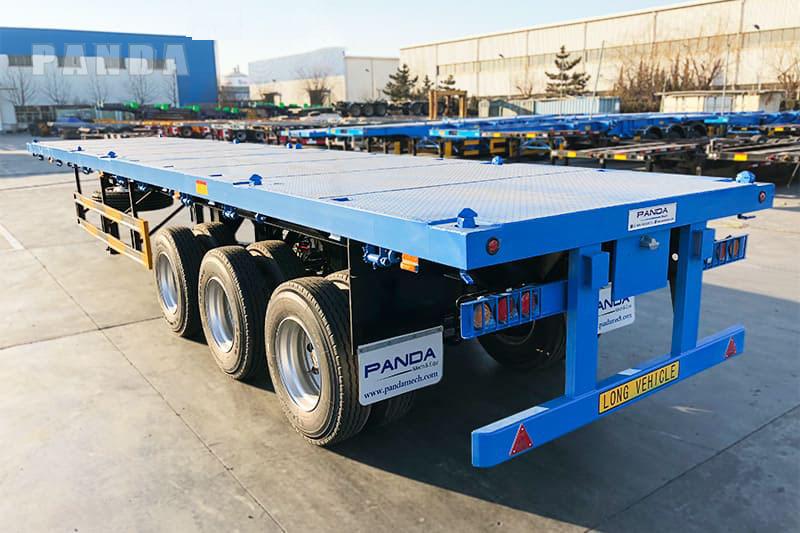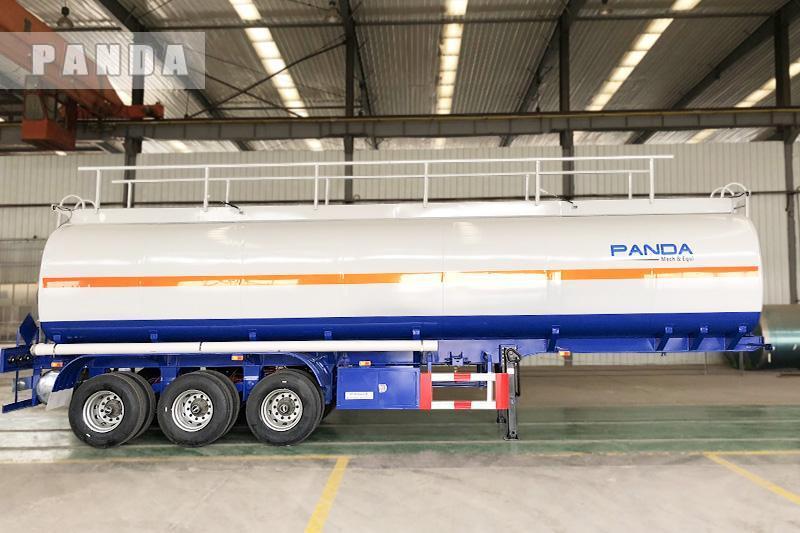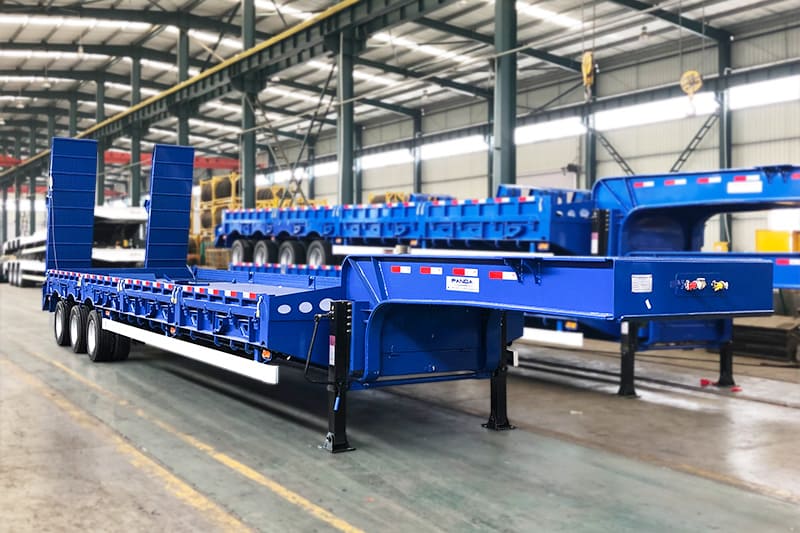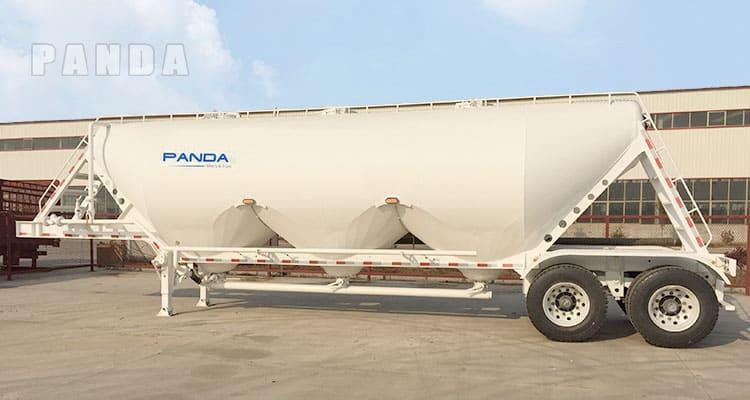Introduction
Have you ever wondered why it’s called a semi-trailer? Semi-trailers are a vital part of the transportation industry, responsible for moving goods and materials from one place to another. They are designed to be towed by a tractor, with the front end resting on the rear of the tractor, creating a unique vehicle combination. In this article, we’ll explore the origin of the name “semi-trailer,” its functions, and its various types. We’ll also look at the advantages of using semi-trailers in transportation.

Definition of a Semi-Trailer
A semi-trailer is a type of trailer without a front axle. This means that a significant portion of the trailer’s weight rests on the tractor that tows it. The name “semi-trailer” comes from the fact that it is only “semi” self-supporting, with the rest of the support coming from the tractor unit.
The Role of the Tractor
Functions of the Tractor
The tractor, also known as the prime mover or towing engine, is the power source for the semi-trailer. It provides the necessary horsepower and torque to pull the loaded trailer, while also carrying the weight of the trailer’s front end. The tractor is equipped with a fifth wheel coupling, which allows for easy connection and disconnection from the semi-trailer.
Compatibility with Different Semi-Trailers
One of the key advantages of semi-trailers is their compatibility with different tractor units. Most tractors can tow various types of semi-trailers, allowing for flexibility in transportation options. This versatility makes it easier for trucking companies and independent drivers to adapt to the specific needs of their clients.
Types of Semi-Trailers
Cement Semi-Trailers
Cement semi-trailers, also known as bulk cement trailers or powder trailers, are specifically designed for transporting cement, fly ash, lime, and other powdered materials. These trailers are equipped with a pneumatic system that uses compressed air to discharge the cement from the trailer into storage silos or other containers. The unique design of these trailers allows for efficient and safe transportation of bulk cement, preventing contamination and reducing the risk of spills.

Flatbed Semi-Trailers
Flatbed semi-trailers are one of the most common types, featuring a flat, open deck without any walls or roof. These trailers are ideal for transporting large, bulky items or goods that can withstand exposure to the elements.

Refrigerated Semi-Trailers
Refrigerated semi-trailers, also known as reefer trailers, are designed to maintain a specific temperature range during transportation. They are essential for transporting perishable goods, such as food and pharmaceuticals.
Fuel tanker semi trailer
Fuel tanker semi-trailers are designed to transport liquids and gases, such as fuel, chemicals, and milk. They feature a cylindrical tank body and are built with materials that can withstand the specific contents being transported.

Lowboy Semi-Trailers
Lowboy semi-trailers have a unique design with a lower deck height, making them ideal for transporting oversized or tall cargo. Their low profile allows for the safe and efficient transport of heavy equipment, such as construction machinery and industrial components.

Dry Van Semi-Trailers
Dry van semi-trailers are enclosed trailers designed to protect goods from the elements and potential theft. They are commonly used for transporting consumer goods, electronics, and other items that require a secure, enclosed environment.
Flour Tanker Semi-Trailers
Flour tanker semi-trailers, also known as flour bulk trailers or flour pneumatic trailers, are designed for the safe and efficient transportation of flour and other fine-grained, powdered food products. Similar to cement semi-trailers, these vehicles are equipped with a pneumatic system that uses compressed air to unload the flour from the trailer into storage silos or other containers. This design allows for a clean and hygienic transfer of flour, reducing the risk of contamination and preserving the quality of the product.

Container Chassis Semi-Trailers
Container chassis semi-trailers, also known as container carriers, are specifically designed to transport shipping containers. These trailers feature a skeletal frame that securely holds one or multiple containers of varying sizes, such as 20-foot, 40-foot, or 45-foot containers. The container chassis is equipped with twist locks, which securely fasten the container to the trailer, ensuring safe transportation.

Palm Oil Tanker Semi-Trailers
Palm oil tanker semi-trailers are specialized tankers designed for the transportation of palm oil and other edible oils. These tankers have insulated compartments to maintain the temperature of the oil and prevent it from solidifying during transit. Additionally, they are built with stainless steel or aluminum to ensure the oil’s purity and prevent contamination. Palm oil tanker trailers are equipped with specialized pumping systems for efficient loading and unloading of the oil at its destination.

Gooseneck Container Chassis Semi-Trailers
Gooseneck container chassis semi-trailers are a specific type of container chassis designed with a raised, curved front section that resembles the neck of a goose. This unique design enables a lower deck height, which in turn allows for the transport of taller shipping containers while adhering to height restrictions on roads and bridges. The gooseneck design also helps to distribute the weight of the container more evenly between the tractor and the trailer, providing greater stability and control during transportation.

ISO Tank Chassis Semi-Trailers
ISO tank chassis semi-trailers are specifically designed for the transportation of ISO tank containers. ISO tanks are large, cylindrical containers made of stainless steel or other durable materials, used for transporting bulk liquids, gases, or powders. These tanks are built to meet International Organization for Standardization (ISO) specifications, ensuring their compatibility with various transportation modes, including road, rail, and sea.

Side Wall Trailer Semi-Trailers
Side wall trailer semi-trailers, also known as drop-side or curtain-side trailers, are a versatile type of semi-trailer designed for the transportation of various goods and materials. These trailers have a flatbed base with removable or hinged side panels, which can be opened or removed for easy loading and unloading of cargo.
The side panels provide added security and protection for the cargo, while still allowing for easy access during the loading and unloading process. Side wall trailers are particularly useful for transporting palletized goods, construction materials, and other items that require both protection and accessibility.

Fence Semi-Trailer
Fence semi-trailers, also known as stake trailers or livestock trailers, are designed for the transportation of various agricultural goods, livestock, and other bulk cargo. These trailers consist of a flatbed base with removable or fixed vertical stakes (fence-like structures) along the sides and sometimes the front and rear of the trailer. The stakes create compartments that secure the cargo and prevent it from moving during transit.

Fence semi-trailers are particularly useful for transporting goods that require ventilation and can withstand exposure to the elements, such as fruits, vegetables, and livestock. The stake design allows for easy loading and unloading of the cargo, while providing adequate support and containment.
Container Side Lifter Semi-Trailer
A container side lifter semi-trailer, also known as a sidelifter or self-loading trailer, is a specialized type of semi-trailer designed for the loading, unloading, and transportation of shipping containers. It is equipped with hydraulic cranes mounted on either side of the trailer, which can lift and position containers onto the chassis or the ground. The side lifter’s cranes can typically handle 20-foot and 40-foot containers, with some models capable of handling 45-foot containers as well.

Container side lifters are particularly useful for transporting containers in situations where there is limited access to overhead cranes or other container handling equipment. They provide a flexible and efficient solution for loading and unloading containers at various locations, such as ports, rail terminals, warehouses, and remote sites.
Bomb Cart Trailer
A bomb cart trailer, also known as a terminal chassis or yard chassis, is a specialized type of semi-trailer designed for moving shipping containers within a container terminal, port, or intermodal facility. Bomb cart trailers are built with a robust, low-profile frame and are equipped with twist locks to securely hold the containers in place during transport.

These trailers are designed to be highly maneuverable, making them suitable for navigating the tight spaces and sharp turns commonly found in container yards. They are typically used for short-distance transportation of containers within the terminal, moving them between storage areas, ship-to-shore cranes, and other handling equipment.
Container Tipper Trailer
A container tipper trailer, also known as a tipping chassis or container dumper trailer, is a specialized type of semi-trailer designed to unload shipping containers by tipping them at an angle, allowing the contents to be emptied efficiently. These trailers are equipped with a hydraulic system that tilts the container at a specific angle, usually between 30 and 45 degrees, depending on the trailer’s design and the cargo being unloaded.

Container tipper trailers are commonly used for transporting and unloading bulk cargo, such as agricultural products, scrap metal, waste materials, and construction debris. The tipping mechanism simplifies the unloading process, reducing the time and labor required to empty the container and increasing operational efficiency.
End Dump semi Trailer
An end dump trailer, also known as a dump truck trailer or rear dump trailer, is a specialized type of semi-trailer designed for transporting and unloading loose materials such as sand, gravel, soil, and construction debris. These trailers feature a large, open-top box or container hinged at the rear, which is raised by a hydraulic system to unload the contents through the back end.

End dump trailers are commonly used in construction, agriculture, mining, and waste management industries due to their ability to efficiently transport and unload large quantities of loose materials. The hydraulic system allows for quick and easy unloading, saving time and labor on job sites.
Side Tipper Trailer
A side tipper trailer, also known as a side dump trailer or lateral dump trailer, is a specialized type of semi-trailer designed for transporting and unloading loose materials such as sand, gravel, soil, and construction debris. Unlike the end dump trailer, the side tipper trailer is designed to unload its contents by tipping them sideways, rather than through the rear of the trailer.

Side tipper trailers are equipped with a hydraulic system that tilts the container to one side, allowing the contents to be emptied efficiently. This design provides some advantages over traditional end dump trailers, such as increased stability during unloading and the ability to unload in confined spaces or on uneven terrain.
Side tipper trailers are commonly used in construction, mining, agriculture, and waste management industries for their efficiency in transporting and unloading large quantities of loose materials.
Lowbed semi trailer
A lowbed trailer, also known as a lowboy trailer or low-loader trailer, is a specialized type of semi-trailer designed for transporting heavy, oversized, or tall equipment and machinery. The key feature of a lowbed trailer is its lowered deck, which sits close to the ground. This design allows for a lower center of gravity, providing increased stability during transportation, and enables the transportation of taller cargo while adhering to height restrictions on roads and bridges.

Lowbed trailers are commonly used for transporting heavy equipment and machinery, such as construction vehicles, large industrial components, and oversized structures. The low deck height allows for easy loading and unloading of the cargo, while the strong and sturdy construction of the trailer ensures safe transportation of heavy loads.
LPG Tanker Semi-Trailer
An LPG tanker semi-trailer, also known as a propane tanker or liquified petroleum gas tanker, is a specialized type of semi-trailer designed for the safe and efficient transportation of LPG (liquefied petroleum gas). LPG is a flammable and potentially hazardous gas, commonly used as fuel in heating appliances, vehicles, and industrial processes.

LPG tanker semi-trailers are equipped with a pressurized tank made of high-strength materials, such as carbon steel or stainless steel, designed to hold the LPG in a liquid state under pressure. The tanks are typically cylindrical in shape, with rounded ends and are insulated to maintain the temperature and pressure of the gas during transport. These trailers also have specialized safety features, such as pressure relief valves and emergency shut-off systems, to ensure the safe handling and transportation of LPG.
Advantages of Semi-Trailers
Versatility
As mentioned earlier, semi-trailers offer a high degree of versatility, thanks to their compatibility with various tractor units and their ability to transport different types of cargo. This versatility allows trucking companies and drivers to easily adapt to the changing needs of their clients.

Efficiency
Semi-trailers are designed to maximize cargo space and payload capacity, enabling the efficient transportation of goods over long distances. The tractor and semi-trailer combination allows for easy maneuverability, even in tight spaces, making it a more efficient option compared to rigid trucks.
Cost-Effectiveness
Using semi-trailers can be more cost-effective compared to other transportation methods. The ability to transport a large amount of cargo in a single trip reduces fuel costs and overall transportation expenses. Additionally, the flexibility of being able to switch between different types of trailers makes it easier to optimize fleet usage and reduce idle time.
Conclusion
In conclusion, the term “semi-trailer” comes from its unique design, where it relies on a tractor unit for support and mobility. The semi-trailer’s versatility, efficiency, and cost-effectiveness have made it a critical component of the transportation industry. With various types of semi-trailers available, transportation is becoming more and more efficient.



